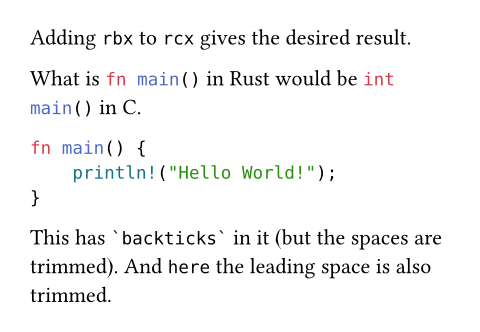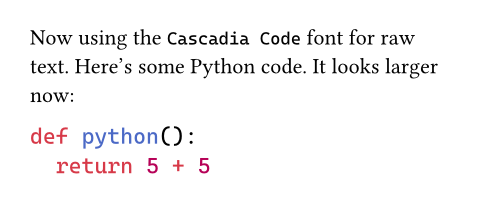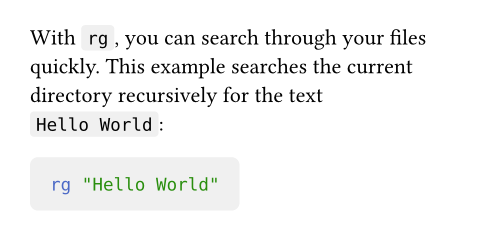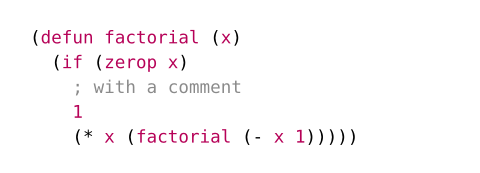rawElement
Raw text with optional syntax highlighting.
Displays the text verbatim and in a monospace font. This is typically used to embed computer code into your document.
Note that text given to this element cannot contain arbitrary formatting,
such as *strong* or _emphasis_, as it is displayed verbatim. If
you'd like to display any kind of content with a monospace font, instead of
using raw, you should change its font to a monospace font using the
text function.
Example
Adding `rbx` to `rcx` gives
the desired result.
What is ```rust fn main()``` in Rust
would be ```c int main()``` in C.
```rust
fn main() {
println!("Hello World!");
}
```
This has ``` `backticks` ``` in it
(but the spaces are trimmed). And
``` here``` the leading space is
also trimmed.

You can also construct a raw element programmatically from a string (and
provide the language tag via the optional lang argument).
#raw("fn " + "main() {}", lang: "rust")

Syntax
This function also has dedicated syntax. You can enclose text in 1 or 3+
backticks (`) to make it raw. Two backticks produce empty raw text.
This works both in markup and code.
When you use three or more backticks, you can additionally specify a language tag for syntax highlighting directly after the opening backticks. Within raw blocks, everything (except for the language tag, if applicable) is rendered as is, in particular, there are no escape sequences.
The language tag is an identifier that directly follows the opening backticks only if there are three or more backticks. If your text starts with something that looks like an identifier, but no syntax highlighting is needed, start the text with a single space (which will be trimmed) or use the single backtick syntax. If your text should start or end with a backtick, put a space before or after it (it will be trimmed).
If no syntax highlighting is available by default for your specified
language tag (or if you want to override the built-in definition), you may
provide a custom syntax specification file to the
syntaxes field.
Styling
By default, the raw element uses the DejaVu Sans Mono font (included
with Typst), with a smaller font size of 0.8em (that is, 80% of
the global font size). This is because monospace fonts tend to be visually
larger than non-monospace fonts.
You can customize these properties with show-set rules:
// Switch to Cascadia Code for both
// inline and block raw.
#show raw: set text(font: "Cascadia Code")
// Reset raw blocks to the same size as normal text,
// but keep inline raw at the reduced size.
#show raw.where(block: true): set text(1em / 0.8)
Now using the `Cascadia Code` font for raw text.
Here's some Python code. It looks larger now:
```py
def python():
return 5 + 5
```

In addition, you can customize the syntax highlighting colors by setting
a custom theme through the theme field.
For complete customization of the appearance of a raw block, a show rule
on raw.line could be helpful, such as to add line numbers.
Note that, in raw text, typesetting features like hyphenation, overhang, CJK-Latin spacing (and justification for raw blocks) will be disabled by default.
Parameters
text
The raw text.
You can also use raw blocks creatively to create custom syntaxes for your automations.
 View example: Implementing a DSL using raw and show rules
View example: Implementing a DSL using raw and show rules
// Parse numbers in raw blocks with the
// `mydsl` tag and sum them up.
#show raw.where(lang: "mydsl"): it => {
let sum = 0
for part in it.text.split("+") {
sum += int(part.trim())
}
sum
}
```mydsl
1 + 2 + 3 + 4 + 5
```

block
Whether the raw text is displayed as a separate block.
In markup mode, using one-backtick notation makes this false.
Using three-backtick notation makes it true if the enclosed content
contains at least one line break.
 View example
View example
// Display inline code in a small box
// that retains the correct baseline.
#show raw.where(block: false): box.with(
fill: luma(240),
inset: (x: 3pt, y: 0pt),
outset: (y: 3pt),
radius: 2pt,
)
// Display block code in a larger block
// with more padding.
#show raw.where(block: true): block.with(
fill: luma(240),
inset: 10pt,
radius: 4pt,
)
With `rg`, you can search through your files quickly.
This example searches the current directory recursively
for the text `Hello World`:
```bash
rg "Hello World"
```

Default: false
lang
The language to syntax-highlight in.
Apart from typical language tags known from Markdown, this supports the
"typ", "typc", and "typm" tags for
Typst markup,
Typst code, and
Typst math, respectively.
 View example
View example
```typ
This is *Typst!*
```
This is ```typ also *Typst*```, but inline!

Default: none
align
The horizontal alignment that each line in a raw block should have.
This option is ignored if this is not a raw block (if specified
block: false or single backticks were used in markup mode).
By default, this is set to start, meaning that raw text is
aligned towards the start of the text direction inside the block
by default, regardless of the current context's alignment (allowing
you to center the raw block itself without centering the text inside
it, for example).
 View example
View example
#set raw(align: center)
```typc
let f(x) = x
code = "centered"
```

Default: start
syntaxes
Additional syntax definitions to load. The syntax definitions should be
in the sublime-syntax file format.
You can pass any of the following values:
- A path string to load a syntax file from the given path. For more details about paths, see the Paths section.
- Raw bytes from which the syntax should be decoded.
- An array where each item is one of the above.
 View example
View example
#set raw(syntaxes: "SExpressions.sublime-syntax")
```sexp
(defun factorial (x)
(if (zerop x)
; with a comment
1
(* x (factorial (- x 1)))))
```

Default: ()
theme
The theme to use for syntax highlighting. Themes should be in the
tmTheme file format.
You can pass any of the following values:
none: Disables syntax highlighting.auto: Highlights with Typst's default theme.- A path string to load a theme file from the given path. For more details about paths, see the Paths section.
- Raw bytes from which the theme should be decoded.
Applying a theme only affects the color of specifically highlighted
text. It does not consider the theme's foreground and background
properties, so that you retain control over the color of raw text. You
can apply the foreground color yourself with the text function and
the background with a filled block. You could also use
the xml function to extract these properties from the theme.
 View example
View example
#set raw(theme: "halcyon.tmTheme")
#show raw: it => block(
fill: rgb("#1d2433"),
inset: 8pt,
radius: 5pt,
text(fill: rgb("#a2aabc"), it)
)
```typ
= Chapter 1
#let hi = "Hello World"
```

Default: auto
tab-size
The size for a tab stop in spaces. A tab is replaced with enough spaces to align with the next multiple of the size.
 View example
View example
#set raw(tab-size: 8)
```tsv
Year Month Day
2000 2 3
2001 2 1
2002 3 10
```

Default: 2
Definitions
lineElement
A highlighted line of raw text.
This is a helper element that is synthesized by raw elements.
It allows you to access various properties of the line, such as the line number, the raw non-highlighted text, the highlighted text, and whether it is the first or last line of the raw block.
number
The line number of the raw line inside of the raw block, starts at 1.
count
The total number of lines in the raw block.
text
The line of raw text.
body
The highlighted raw text.